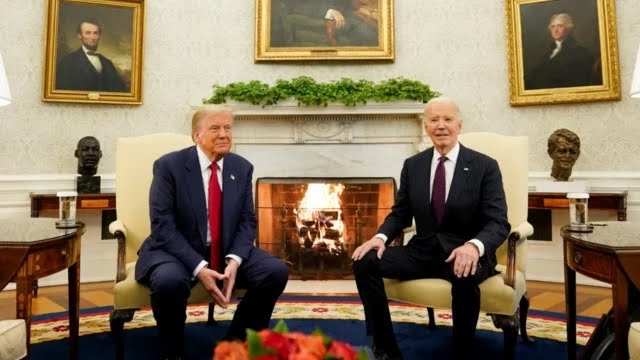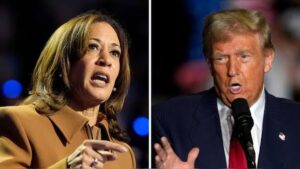
“Welcome Back: What the Biden-Trump Meeting Means for America’s Political Divide”
In a recent and unexpected turn of political theater, former President Donald Trump and President Joe Biden met face-to-face, sparking a firestorm of speculation, division, and excitement across the political landscape. For many Americans, the image of Biden and Trump standing together was simultaneously surreal, symbolic, and deeply controversial. This brief yet highly charged interaction marks a rare moment in U.S. politics, one that speaks volumes about the state of the country—and it could be a precursor to the direction in which American politics is headed.
A Symbolic “Welcome Back”
While the details of their meeting have been kept under wraps, sources close to both camps suggest the encounter may have been intended as a display of solidarity in a divided nation. However, for supporters on both sides, it has reignited debates over unity, populism, and the role of the presidency itself. For Trump supporters, the meeting felt like a “welcome back” moment, a potential preview of his renewed influence and the possibility of a 2024 bid that would see him return to the Oval Office. To Biden’s base, the meeting has been cast in a very different light: a begrudging acknowledgment of Trump’s lasting impact on the American political landscape, even as Biden seeks to consolidate the legacy of his own administration.
Trump’s Influence and Biden’s Legacy
Trump’s meteoric rise and lasting influence are hard to deny. Despite Biden’s victory in 2020, Trump’s presence continues to loom large over American politics. His appeal to a significant segment of the American population remains strong, and he has capitalized on a unique charisma that has empowered a new wave of populist conservatives. Biden’s decision to meet with Trump, therefore, is fraught with complexity. By doing so, Biden acknowledges Trump’s continuing impact on the national conversation—an implicit admission that Trump has not been as easily sidelined as many Democrats once hoped.
For Biden, this meeting also raises questions about his own leadership and legacy. Biden ran as the antidote to Trumpism, and his administration has worked to reverse many of Trump’s policies. This meeting could be seen as a concession of sorts—a recognition that Biden’s presidency, for all its intended reforms, cannot escape the enduring shadow of the Trump years.
An Unlikely Symbol of Unity?
One of the most polarizing aspects of the Biden-Trump meeting is the perception of unity it implies. Biden has long promoted a message of reconciliation, reaching across the aisle in an attempt to bridge the deep divisions within the country. However, Trump’s core supporters are not necessarily interested in unity; for them, Trump represents an alternative to the political establishment and a rebellion against perceived elitism. Similarly, many Biden supporters are fundamentally opposed to the divisive rhetoric that Trump represents. The idea that Biden and Trump could somehow “come together” seems, to some, nothing short of betrayal.
The divisive symbolism of the meeting cuts both ways. For Trump supporters, the meeting is proof of his continued importance and a rebuke to Biden’s attempt to marginalize their vision of America. For Biden supporters, it is a disheartening reminder that Trump’s legacy remains powerful enough to warrant the attention of a sitting president.
Political Posturing or Necessary Pragmatism?
Another interpretation of the Biden-Trump meeting is that it was an exercise in political posturing. Some argue that Biden’s team arranged the meeting as a calculated move to show that he is not afraid of his most famous adversary. It’s a tactic often used in politics—to face down the opposition in a gesture that could be perceived as an olive branch, but also as a show of strength.
In doing so, Biden may be betting that such a meeting will disarm Trump’s most ardent supporters or at least neutralize Trump’s narrative that Biden is weak and unwilling to engage. Conversely, Trump may have used this meeting to project himself as a statesman—one who is willing to set aside past animosities for the good of the nation, even as he plots a possible return.
However, critics argue that this move is a dangerous gamble for Biden, as it risks normalizing Trump’s contentious and often divisive brand of politics. In trying to engage Trump, Biden may inadvertently legitimize him, giving the former president precisely what he craves: relevance.
The Meeting’s Impact on the 2024 Race
For both Trump and Biden, the 2024 presidential election looms large in the background of this meeting. With Trump widely expected to run, the specter of a rematch has already gripped the media. By meeting with Trump now, Biden may be trying to preemptively blunt his opponent’s momentum. However, Trump has historically thrived in direct confrontations with political opponents, often using these encounters to galvanize his base.
For the Democrats, this meeting is controversial in that it puts Trump back in the spotlight—something many in the party had hoped to avoid. By sharing the stage with him, Biden risks elevating Trump’s platform just as his campaign might be gearing up for another run. Republicans, on the other hand, may interpret the meeting as validation of Trump’s continued relevance and influence. The GOP’s identity has been reshaped in Trump’s image, and any sign of cooperation between Biden and Trump could bolster Trump’s support by reminding his base that he is still seen as a serious contender.
The Dangers of Normalization
Perhaps the most contentious aspect of the Biden-Trump meeting is the risk of normalizing Trump’s brand of populism and aggressive rhetoric. Trump’s approach to politics often flouts convention, embracing a style that critics say has coarsened political discourse and undermined democratic norms. For Biden to meet with Trump in a seemingly amicable setting sends a mixed message about the acceptability of Trump’s behavior.
Critics argue that this meeting risks downplaying the dangers of Trump’s approach, effectively sending a message that it is merely another political perspective rather than an existential threat to the nation’s values. If Biden’s aim was to demonstrate tolerance or open-mindedness, he may have achieved it—but at a significant cost. By sharing the stage, Biden risks undercutting the moral high ground he has sought to occupy and diminishing the severity of the issues that separate him from Trump.
A Defining Moment for America’s Future?
Ultimately, the Biden-Trump meeting serves as a mirror for America, reflecting the complexities, contradictions, and passions that define the current political climate. It brings into sharp relief the differences between a traditionalist vision of American leadership and an unconventional, populist alternative. The lasting impact of this meeting remains to be seen, but one thing is clear: in a nation as deeply divided as the United States, even a brief encounter between Biden and Trump is enough to stir powerful emotions on both sides of the aisle.
As Americans continue to debate the significance of this unprecedented interaction, the Biden-Trump meeting stands as both a symbol of unity and a source of division. For some, it is a sign of the resilience of the democratic process; for others, a betrayal of core values. Whatever the interpretation, one thing is certain: this moment will be remembered as a defining chapter in the story of American politics—and one that could shape the direction of the country for years to come.






